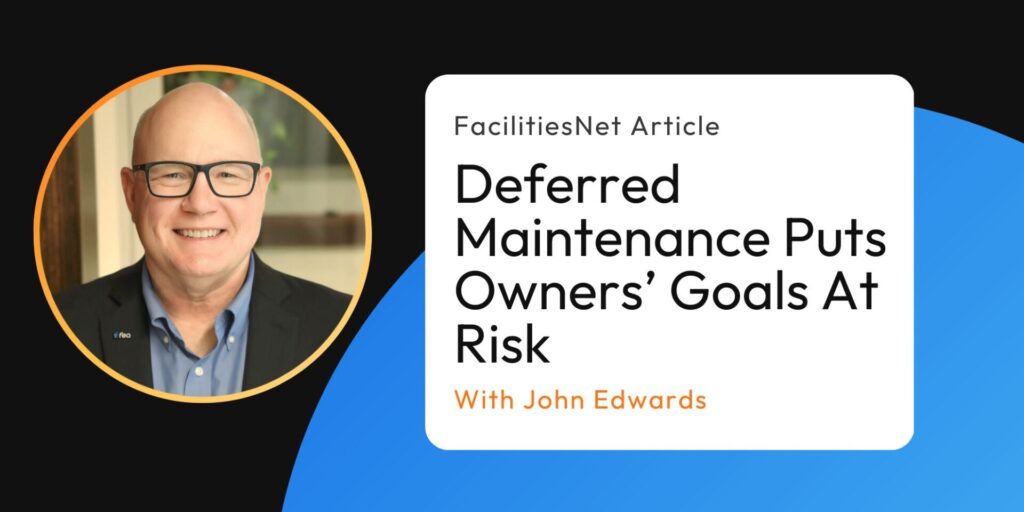John Edwards on the Risks of Deferred Maintenance Backlog
Building owners have heard the warnings about repair backlogs for decades, but the stakes are higher than ever.
In a recent interview with Facility Maintenance Decisions, shared his perspective on the risks of deferred maintenance backlog and how it threatens both the short- and long-term goals of building owners.
The Challenge of Big Backlog Numbers
According to Edwards, one of the reasons owners fail to act is the way deferred maintenance is presented. “Owners often get handed a report with a massive backlog figure – $100 million, $800 million, even $2 billion. It’s supposed to be scary, but it ends up feeling impossible. The number is so big that leadership tunes it out.”
That mindset, however, comes with serious risks. Ignoring maintenance doesn’t make problems disappear. Instead, it can compromise safety, security, resilience, and even the long-term value of facilities portfolios.
Safety and Security at Risk
Edwards cautioned that while many building systems have built-in redundancy, relying on backup systems alone is not sustainable. “Owners depend on building systems to provide a safe, healthy, productive environment. If critical items like doors, fire protection systems, or security hardware aren’t maintained, liability exposure grows dramatically.”
He pointed to real-world consequences. In one case at a university, leadership delayed addressing deferred maintenance on steam systems. The result was catastrophic: pipes froze and burst, flooding facilities and forcing the cancellation of winter semester classes. The failure wasn’t a surprise; it had been on the deferred maintenance list for years.
Impacts on Resilience and Capital Planning
Beyond immediate risks, deferred maintenance undermines resilience and disrupts capital planning. Edwards explained that owners sometimes defer updates because systems are still operating, but that choice often backfires. “Within a few years, you’ve got a failing system in a newly renovated space, and you’re tearing into walls to replace it. The short-term savings create long-term costs.”
Resilience also suffers when neglected systems disrupt business continuity. As Edwards put it, deferred maintenance is not just about the system itself – it’s about the organization’s ability to function when challenges arise.
Protecting Long-Term Value
Perhaps the most significant impact of the risks of deferred maintenance backlog is its effect on facility portfolios. Edwards noted that deferred maintenance shows up as a liability on balance sheets and reduces asset value. “If your building can’t serve its mission because of deferred maintenance, you take a direct hit to the bottom line. The asset is worth less because it hasn’t been maintained.”
For facility managers, the task is clear: they must communicate the risks in financial and organizational terms. Edwards emphasized the importance of framing the issue for leaders such as CFOs and risk officers, not just facilities staff. “It’s really an organization issue, not just a facilities problem.”
A Persistent but Urgent Problem
Deferred maintenance may feel like background noise after decades of discussion, but Edwards warns that ignoring it is a costly mistake. The risks extend from daily safety to long-term capital planning and asset value. Owners who continue to delay face growing liabilities and shrinking options.
As Edwards told Building Operations Management, the solution lies in reframing the issue: deferred maintenance is not simply about fixing what’s broken—it’s about protecting people, sustaining operations, and ensuring the long-term success of organizations.
Read the full article here.




